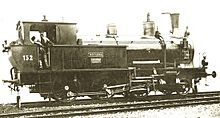Jura neuchâtelois
The Jura neuchâtelois (JN) or Neuchâtel Jura Railway is a former Swiss railway company.
history

The company was founded on January 1, 1886, after the Neuchâtel electorate decided on June 29, 1884 to buy back the 38-kilometer Neuchâtel – Le Locle-Col-des-Roches railway from the Jura – Bern – Lucerne (JBL). The initiative to buy back had been taken because the population was no longer satisfied with the services of the railway company.
The railway line from Neuchâtel through the 3259 meter long Loges tunnel between Les Hauts-Geneveys and Convers to La Chaux-de-Fonds and Le Locle was opened in four stages between July 2, 1857 and July 15, 1860 by the Jura industriel ( JI), which went bankrupt after a few months. The canton then operated the line itself until a second company of the same name was founded in 1865 to take over operations. In a referendum in 1875, the canton rejected the repurchase of the railway, whereupon the JI sold its line to the Jura bernois (JB) on May 1, 1875 , which also leased the line of the bankrupt Bern-Lucerne railway (BLB) and its name then changed to Jura – Bern – Lucerne (JBL) on July 1, 1884 .
Only under the JBL did the line to the Swiss / French border at Le Locle-Col-des-Roches (formerly called “ Brenets-Col-des-Roches ”) open on August 4, 1884, and the merger with the French railway network via Morteau leading railway Besançon-Le Locle .
After the repurchase of the route from JBL and the founding of JN, JBL opened the 1618 meter long Crosettes tunnel between Le Creux and La Chaux-de-Fonds on December 17, 1888, making the direct journey between Biel and La Chaux-de-Fonds possible. Fund without a hairpin at Convers became possible. This also immediately stopped rail traffic on the section between Convers and Le Creux. However, the route was not canceled until July 1, 1895 under the Jura-Simplon Railway (JS), with rudiments of the railway systems remaining well into the 20th century. After the stop has been dissolved in Convers on request, only the platform can be seen there; the track branching off in the direction of Le Creux still runs under the motorway bridge and has not yet been dismantled. .
After the nationalization of the five major railway companies, the canton of Neuchâtel also wanted to integrate its railway into the SBB. It was only when Louis Perrier from Neuchâtel became a federal councilor in April and took over the postal and railroad department that a purchase agreement was signed with the Swiss Confederation on November 4, 1912 to integrate the line into the Swiss Federal Railways (SBB) on July 1, 1913 . On October 4, 1931, the SBB started electrical operations under 15 kV 16⅔ Hz alternating current , between Neuchâtel and Le Locle-Col-des-Roches.
Locomotives
JI procured two- and three-coupled Engerth locomotives from Esslingen and from the SCB workshop in Olten. The two-coupled machines (numbers 1–3, JBL 41–43) did not meet the requirements of the mountain route and were retired in 1883 and 1888. Due to the company's payment difficulties, the three-coupled locomotives (numbers 4–7, JBL 141–143) could not be paid for in full, which is why the SCB retained locomotive number 6 and used it itself. In 1873 two three-coupled machines came from Esslingen (numbers 6 and 8, JBL 144 and 145), one of which went over to the SBB (8799).
During the operating time by JBL, various locomotives from their entire inventory were used, so that the newly founded JN, which took over locomotives 42 and 141-145 along with the line, was the first to have to procure new locomotives. These came in 1886, 1897 and 1899 as three-coupled tank locomotives with leading running axles from SLM in Winterthur . They bore the numbers 146 to 153 and were classified as Ec 3/4 from 1902. They were then in operation with the SBB as 6551–6558 until the second half of the 1930s.
As the last acquisition of the JN in 1903, two powerful Ed 4/5 154–155 were again put into operation by SLM, which, however, was retired from the SBB as a splinter type with the numbers 7701–7702 as early as 1923. 7701 then came to the Mittelthurgau Railway as number 7 , where it was in operation until the Second World War.
literature
- Johann Boillat: Une ligne à travers les montagnes: . la première compagnie de chemin de fer du Locle à Neuchâtel: le Jura industriel (1857–1865). Éditions Alphil, Neuchâtel 2007, ISBN 978-2-940235-36-0 .
- Bernard Renaud: L'histoire du chemin de fer à Neuchâtel , in: Eisenbahn-Amateur 4/2012, ISSN 0013-2764
Individual evidence
- ^ Alfred Moser: The steam operation of the Swiss railways 1847-1966. Birkhäuser Verlag Basel and Stuttgart 1967, fourth redesigned and updated edition, pages 305–307.
- ^ Alfred Moser: The steam operation of the Swiss railways 1847-1966. Birkhäuser Verlag Basel and Stuttgart 1967, fourth newly designed and updated edition, pages 299–301.
- ^ Alfred Moser: The steam operation of the Swiss railways 1847-1966. Birkhäuser Verlag Basel and Stuttgart 1967, fourth redesigned and updated edition, pages 310-313 and 404.
- ↑ Michael Mente: 100 Years of the Mittel-Thurgau-Bahn , in: Eisenbahn-Amateur 11 and 12/2011, ISSN 0013-2764 , picture and reference to locomotive 7 on pages 550, 552 and 610





